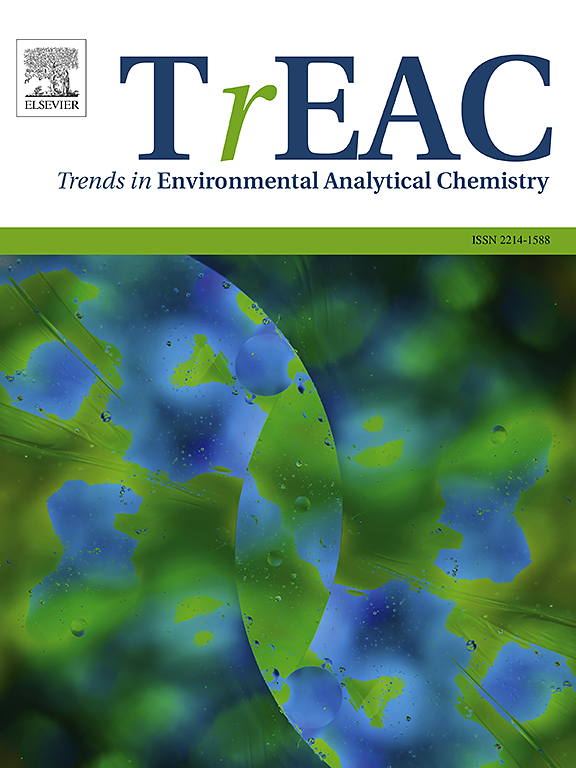Chitosan-based sorbents for the micro-solid-phase extraction of pesticides
IF 11.1
2区 化学
Q1 CHEMISTRY, ANALYTICAL
引用次数: 0
Abstract
The widespread use of pesticides and their hazardous impacts on humans and animals have made their detection and determination a critical issue. However, due to the low concentration of pesticides and the complexity of the entire sample, it is essential to use sample preparation approaches before determining pesticides. Among sample preparation approaches, micro-solid-phase extraction (µ-SPE), as a miniaturized extraction technique, has garnered much attention. This technique decreases the use of materials, reagents, and solvents. Additionally, µ-SPE applies micro- and/or nano-based sorbents and employs miniaturized extraction gadgets and devices. The attributes of µ-SPE, plus the concepts of green analytical chemistry, have encouraged analytical scientists to introduce and use green and environmentally friendly materials in µ-SPE techniques. Chitosan (CS) is a biocompatible, low- or negligible-toxic, environmentally friendly, and cost-effective material. Another valuable property of CS is its capability for modification and combination with different compounds. CS-based materials not only address the problems of traditional sorbents but also introduce new ones with excellent features such as high stability, high adsorption capacity, etc. These factors motivated us to assess the recent development in using CS-based sorbents for the µ-SPE of pesticides from 2016 to 2025. In this article, the properties of CS are illustrated. Different CS composites and the possible mechanisms for extracting pesticides are reviewed. Finally, the current trends and prospects related to using CS-based sorbents in the µ-SPE of pesticides are summarized. This review article investigates the properties and utilizations of CS-based materials as sorbents in µ-SPE, highlighting their potential to revolutionize pesticide determination.
壳聚糖基吸附剂用于农药微固相萃取
农药的广泛使用及其对人类和动物的有害影响使其检测和确定成为一个关键问题。然而,由于农药浓度低,整个样品的复杂性,在确定农药之前必须使用样品制备方法。在样品制备方法中,微固相萃取(micro-solid-phase extraction, micro -SPE)作为一种小型化的萃取技术受到了广泛的关注。这种技术减少了材料、试剂和溶剂的使用。此外,µ- spe适用于微型和/或纳米基吸附剂,并采用小型化的萃取装置和设备。µ-SPE的特性,加上绿色分析化学的概念,鼓励分析科学家在µ-SPE技术中引入和使用绿色环保材料。壳聚糖(CS)是一种具有生物相容性、低毒性或可忽略不计的、环保的、高性价比的材料。CS的另一个有价值的特性是它的改性和与不同化合物结合的能力。cs基材料不仅解决了传统吸附剂的问题,而且还引入了具有高稳定性、高吸附容量等优异特性的新型吸附剂。这些因素促使我们评估了2016年至2025年在农药微spe中使用CS-based吸附剂的最新发展。本文阐述了CS的特性。综述了不同的CS复合材料及其提取农药的可能机理。最后,总结了cs基吸附剂在农药微固相萃取中的应用现状和前景。本文综述了cs基材料在μ -SPE中作为吸附剂的性能和应用,强调了它们在农药测定中的革命性潜力。
本文章由计算机程序翻译,如有差异,请以英文原文为准。
求助全文
约1分钟内获得全文
求助全文
来源期刊

Trends in Environmental Analytical Chemistry
Chemistry-Analytical Chemistry
CiteScore
21.20
自引率
2.70%
发文量
34
审稿时长
44 days
期刊介绍:
Trends in Environmental Analytical Chemistry is an authoritative journal that focuses on the dynamic field of environmental analytical chemistry. It aims to deliver concise yet insightful overviews of the latest advancements in this field. By acquiring high-quality chemical data and effectively interpreting it, we can deepen our understanding of the environment. TrEAC is committed to keeping up with the fast-paced nature of environmental analytical chemistry by providing timely coverage of innovative analytical methods used in studying environmentally relevant substances and addressing related issues.
 求助内容:
求助内容: 应助结果提醒方式:
应助结果提醒方式:


